|
Chapter One
To Leeds
February 8th 1941 : The Middle East.
British Forces occupy the eastern half of Libya as far as the town of El Agheila.
February 12th 1941 :
General Irwin Rommel, veteran of the Polish and French Campaigns arrives in Tripoli to take command of The Afrika Korps.
March 11th 1941:
The Fifth Panzer Regiment completes its disembarkation in Tripoli. Rommel and The Afrika Korps had been sent to North Africa to support the demoralised Italians after their collapse in the face of the British advance. Rommel`s objective was to seize the Suez Canal and ultimately the oil fields that lay beyond.
March 12th 1941: The United Kingdom.
Loud cheering greets Prime Minister Churchill`s announcement in The House of Commons regarding the signing of the U.S. Lease and Lend Bill. The Lend Lease Act gave President Roosevelt powers to sell, transfer title to, exchange, lease, lend, or otherwise dispose of equipment for the defence of any country upon which the United States` own defence was
thought to depend. The Act allowed Roosevelt to extend U.S. Involvement in the war without compromising neutrality by direct intervention.
March 13th 1941:
Against these events on the worldwide stage, Albert Morrell a Trolley Bus Conductor and Father of two children Albert and Ivy and Husband to Josephine, of 56 Carlyle street, Sinfin lane, Derby, enlisted at No.11 Depot T.E.RAMC Beckett Park, Leeds. He was now 7395556 Pte. Albert Morrell RAMC.
No.11 Depot and Training Establishment had opened at Beckett Park on December the 1st 1939. Recruits undertook a special intensive course of training in technical subjects extending over two months. Albert completed recruit training in War No.11 Depot on the 15th of May 1941.
|
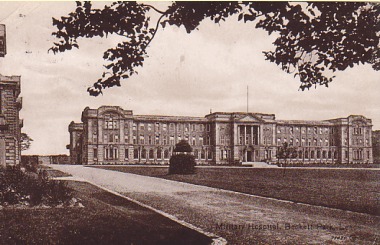
|
|
Beckett Park, Main Hospital Building
|
|
|
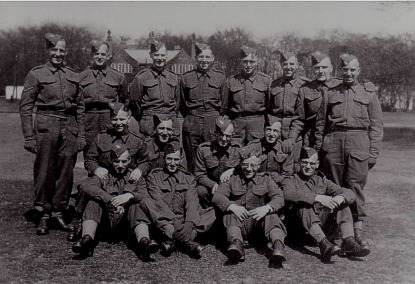
|
|
Albert standing far right, Beckett Park 1941
|
|
In front of Churchwood Building
|
|
|
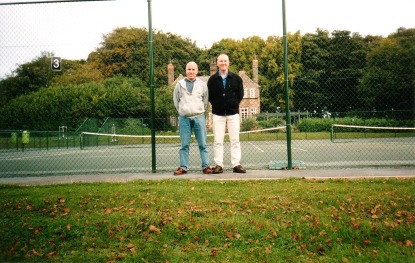
|
|
Albert`s Son and Grandson, Beckett Park 2000
|
|
In front of Churchwood Building
|
|
The first of my recollections comes from Mr. McFarlane who was on the staff at Beckett Park at the time that Albert would have been training there.
Mr. R. McFarlane. RAMC:
We were in Macauly building and we got in a new batch of recruits every six weeks. We started them straight from civilian life and were expected to turn out trained troops. Things didn`t always work out that way of course, but in the main it became very routine, the only difference being the men involved.
They came from all walks of life and from all parts of the country, so they were really a mixed bunch in attitude and ability.
There were 30 men in each platoon and they were housed in the block and ate there. At the right times we got them up, breakfasted, then out on the routine. From the block we marched them off to the main building and there they were handed over to other staff who took them on for drill, dentistry, medical training and anything else the Army could think of.
When they first arrived we took them off to one of the blocks where they were issued with mattress covers, which they filled with straw and hay and this became their bed for six weeks. Each Sunday morning it was church parade and we marched them down to St.James Church. When watching cricket tests from Headingly you will always see a church spire in the background, this is the one we used each Sunday.
One block had a swimming pool and the men were taught how to take casualties over the water. At the end of the training period there was a route march, we of course knew the same route each time and were familiar with not only the road, but the pubs along it. It was usually some 20 miles and took up a day of training. At the end of the six weeks they were given a few days leave and received their posting orders, being sent to various units, usually as nursing orderlies.
All were fitted out with uniforms and there was a tailors shop in one of the buildings so the sewing on of all the insignia was no problem. Regular checks were carried out of the sleeping areas and all kit. We had on the staff several sergeants from other regiments, and these carried out all the drill the recruits were expected to do. It all helped to fill in time because it was difficult to find things to occupy them when they were not on their nursing training.
When training was complete and they had done their exams they were usually sent home for up to a week on leave and their new orders were sent by post. There was no fixed line of posting and in fact they could be sent anywhere.
The recruit training was not in fact as bad as if they had been in other regiments, because there was only the one route march, whereas in other units they would have had battle training which involved a lot of outdoor work.
So far as we were concerned on the staff every intake was exactly the same, the only difference being from which part of the country the recruit had come. From memory, we had very few men who didn`t eventually pass the course.
Tom Bradley shared his memories of Beckett Park, Tom also served with the Royal Army Medical Corps.
Mr. Tom Bradley. RAMC:
Regarding Beckett Park Depot, this was a Teacher Training College before the war and was taken over by the military and used as an RAMC depot for troops going overseas. During my time at Beckett Park the troops were billeted in private houses taken over by the military. We were in an empty house, 12 Grove Lane, about a mile from Beckett Park, each morning at about 6.30 am we marched as a troop to the depot for breakfast. We were there in December and it was
quite dark in the early hours, therefore to avoid accidents someone in the front and someone in the back row had to carry a lit hurricane lamp.
During our stay there we were kitted out for overseas service and had the necessary inoculations against tropical diseases. We usually finished our day by lunchtime and in the afternoons spent our time in our billets reading and writing letters etc. and doing our washing under very primitive conditions. In the evenings we would probably go into Leeds and visit the cinema or go for a meal in one of the many wartime canteens, or go to the pub for a drink. If my memory serves me correctly the Grange was the Officers quarters.
|
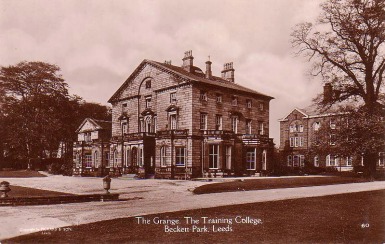
|
|
The Grange, Beckett Park
|
|
My final recollection of Beckett Park comes from a Gentleman who also served with the Royal Army Medical Corps, Tom Sims.
Mr. Tom Sims. RAMC:
Beckett Park does not seem to have changed very much.
My reason for being there was, when one was promoted, they were sent to Depot for training in the “Kings Rules and Regulations” and various other things needed to a unit.
My first stint at No.11 Depot was from 14/11/41 for one month, my second from 19/1/43 to 12/2/43, so it is unlikely that I would have come into contact with Albert.
Beckett Park as I now recall was an initial training centre, a separate wing for the courses I`ve already mentioned and also a wing for the A.T.S.(Womens Army).
The N.C.O`s courses were held in Fairfax Hall. We were billeted on the top floor, the remainder of the building was devoted to lecture and demonstration rooms, kitchen and dining rooms.
|
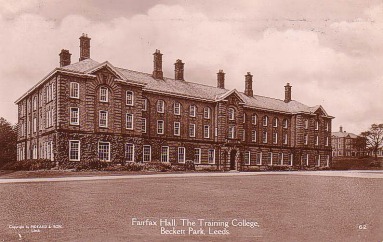
|
|
Fairfax Hall, Beckett Park
|
|
As I recall Carnegie Hall was for training and housing the A.T.S., I will say that the women soldiers provided an excellent distraction during the leisure hours.
My final memory of Beckett Park, is of being called upon to referee a couple of matches between the RAMC training staff and Leeds utd. Colts.
August 8th 1941:
Training over, Albert was posted to No. 1 Depot R.A.M.C. Boyce Barracks.
Les Powell, who also served with the Royal Army Medical Corps remembers Boyce Barracks.
Mr. Les Powell. RAMC :
The Base Depot for the RAMC was at Crookham in Hampshire, 5 miles from Aldershot, the place was called Boyce Barracks.
My friend Alec Adamson served with the Royal Army Medical Corps, Alec has written about his time at Boyce Barracks in his book, “Experiences in the Royal Army Medical Corps in the Second World War”.
Mr. Alec Adamson. RAMC :
A few weeks after joining up we moved to the new Boyce Barracks, where the drill square was of smooth tarmac and it was almost a joy to go on drill parade. Over the years since the war I have a recurring dream in which I have been hurrying against hopeless odds to get on parade on time, usually due to one or other of my items of uniform being missing.
Along with drilling we had lectures in first aid and the rudiments of nursing. My old notes show that we were taught bandaging, treatment of various types of wounds, burns, snake bites, the use of antiseptics, sterilising instruments for operating
and so on. We were also taken through a gas chamber where we had to ease off one side of the respirator in order to take a good sniff of the gas for recognition purposes.
One memorable event of our stay at the depot was when we were paraded on nearby Tweseldown Racecourse. We had no idea what was afoot and were lined up on either side of the road. Eventually a procession flanked with outriders on motorbikes came along. It turned out to be King George the sixth and Queen Elizabeth (now the Queen Mother) along with Neville Chamberlain, the then Prime Minister.
Alec Leete served with the Royal Army Medical Corps, a little after Albert`s time. Alec very kindly gave me a copy of his Boyce Barracks, drill square photo.
|
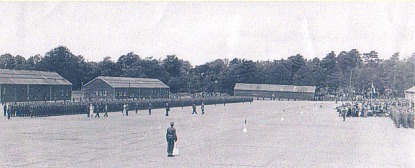
|
|
On Parade, Boyce Barracks. (Alec Leete)
|
|
Mr. Alec Leete. RAMC:
This photo was taken on the occasion of the then Queen`s visit to Boyce Barracks to celebrate the jubilee of the formation of the RAMC on 23rd June 1948. It was subsequently renamed Queen Elizabeth Barracks.The photo shows the square with two gymnasiums on the left, the building on the far side of the square is a drill shed where “square bashing” could still be done in bad weather!
Our accommodation at Boyce Barracks was in wooden huts, these were coal fire heated, eight huts being formed into a
“spider” with a central ablution hut at the centre.
The Gurkhas took over from the RAMC at Boyce Barracks, staying for almost thirty years until 2000. The place had changed little over the years. I was told that I would be able to find the same gaps in the fence that were there when I was there!
August 9th 1941:
The day after Albert`s arrival at Boyce Barracks, on the worldwide stage a meeting was planned to take place between Mr. Winston Churchill and Mr. Franklin D. Roosevelt, this was to be the Atlantic Conference.
The pride of the British Fleet, H.M.S. Prince of Wales was anchored in Placentia Bay, Newfoundland, just a few hundred yards from President Roosevelt`s flagship, the heavy cruiser, Augusta. The two world leaders met for the first time at a dinner hosted by Roosevelt aboard the Augusta.
The following day Roosevelt and his advisers were transported to the Prince of Wales and within an hour the two leaders were deep in conversation.
Churchill had hoped to obtain considerable assistance and concessions, but Roosevelt had to contend with a persistent core of isolationists back at home in the United States, to an extent his political hands were tied. An excellent rapport was achieved however between the two leaders and as a result of this historic meeting, the Atlantic Charter came into being. This charter pledged the two countries to defend the Rights of Freedom, Speech and Thought and to establish an International Organisation that would protect the Security of all Nations.
Churchill had hoped for more but a strong feeling of camaraderie flowed between the two men.
Roosevelt`s dilemma was alleviated however, when on September the 4th the U.S. destroyer Greer, was attacked by a U.boat. Roosevelt gave authority to the U.S. Navy to “Shoot to Kill” and charged the German Chancellor, Adolf Hitler with Piracy.
The seeds were sown, sown for the birth of a convoy …….
|